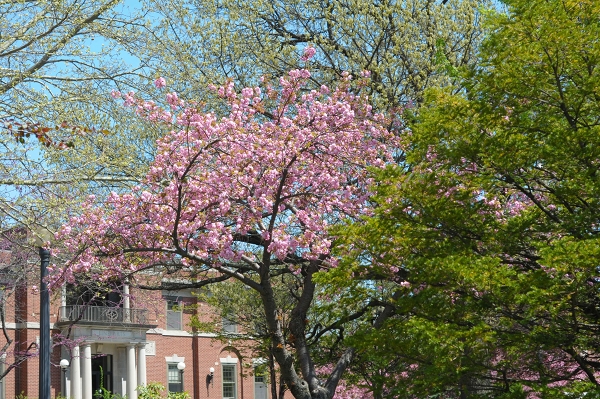Having just returned from Central Pennsylvania, I am still trying to makes sense of my impressions. I was familiar with Lancaster County and the Poconos, but had never ventured west of these areas until now. While I'd imagined a wholesome and fertile land with dramatic mountain views, the landscape we encountered looked bare and depleted. We saw fairly few farm animals, and minimal vegetation. Many of the farms we passed seemed outright abandoned. Later we were told about the extraction of natural gasses that has become popular in the region, so perhaps this could account for it. It would also explain the enormous, brand-new-looking hotels that stood in sparsely populated areas, towering above the Methodist churches and the dilapidated barns.
In the midst of all of this, we came upon a lively small town - a town with historical buildings, tree-lined streets, an active downtown area, and a picturesque Liberal Arts college with manicured grounds. Surrounded by mountains and farmlands, the town forms a microcosm of "culture" - offering the only sidewalks, storefronts, restaurants and cinemas for miles around. Exploring it with curiosity, it occurred to me that this was the sort of place a friend of mine refers to as "cycling-prone" - his theory being that "cycling culture" tends to develop in places that are structurally prepared for it, and where the population could benefit from it.
Among examples of structural preparedness he includes things like one-way streets with low speed limits. Check: This town is big on one-way streets, with speed limits under 30mph. Frequent street lights and well-designed intersections are also crucial, and this town has them. Large intersections involve dedicated left turn lights, which is helpful for cyclists as well.
There is also the concept of "manageable scale:" The argument is that cycling tends to be popular in small cities or towns with self-contained economies, because most commutes will be fairly short - yet still not quite convenient to make on foot. This town fits the bill perfectly: The population is around 30,000 and a great portion of the residents seem to live, work, and seek entertainment within the town's confines, simply because there is not much beyond it. And being in a valley, the terrain is mostly flat - making even the simplest single speed bicycle sufficient for commuting.
And then, there is the college - a small undergraduate institution with 2,000 full-time students who live on or close to campus year-round. College towns are supposed to be especially prone to embracing cycling, because it makes for a quick and inexpensive means of local transportation. College students also tend to be concerned about the environment, and some are drawn to cycling for those reasons. A quick glance at the college website shows that environmental issues are indeed prominent: Projects to reduce carbon footprints are announced, the benefits of a new recycling program are touted.
In short, all the ingredients are there for this to be a cycling town... and yet, it is not. I saw not a single transportation cyclist on the streets, and not a single bicycle locked up near the college campus or elsewhere in town. To me, this is interesting. Why no cycling here, but yes cycling in places like Hanover, NH and Ithaca, NY - where the towns and the surrounding landscapes are demographically and geographically similar? Sure, Central Pennsylvania can be called "old fashioned," and one could argue that cycling is a contemporary trend that will take a long time to reach here. But the same can be said of Northern NH: You won't see any locals outside of Hanover cycling, but within the town itself it is popular. Also, while I have not been to State College, PA - which is not far away - my understanding is that some students do cycle there for transportation as well.
I suppose my point is not so much to analyse this particular town, as to point out that the popularity of cycling cannot be explained with geography and demographics alone. Even with all the ingredients present, there is no guarantee that they will be utilised and combined into a cycling cocktail, if you will. I can only conclude that, in addition to the ingredients, there needs to be a catalyst to make it happen. To shake things up and get things started. And that catalyst could be anything - from an incoming class of trendy freshmen bringing their fixies to campus, to the college instituting a semester-based bicycle rental program, to the town suddenly deciding to paint bike lanes. I wonder whether that could happen in the coming years in this central Pennsylvania town and others like it.
Monday, May 2, 2011
Subscribe to:
Post Comments (Atom)
Blog Archive
-
▼
2011
(631)
-
▼
May
(77)
- Midlife Motorcycle Madness $25.00 J&P Cycles Gift ...
- WHEATIES® Sponsors Designing Spaces’ Kitchen Renov...
- A Swedish Guest
- 1933 Model 40 Norton
- Russian LNG Exports to Expand Dramatically in the ...
- All-New Ford Ranger Goes Big On Creature Comforts
- Right of Way and Driver Education
- #1 Gift Idea No. 1 Fathers Day Gift Seniors 911 He...
- 1929 Model 16H engine - For sale
- Cycling and Sun Damage
- IZOD IndyCar Series Ticket Giveaway At Zimbrick Ho...
- 3 Wheels and a Box: the Christiania Cargo Trike
- 1928 Model 18 Norton - For sale
- Misadventures on the MUP
- Go Cocktails Sugar Free Cocktails Makes Debut At P...
- Stanley Woods, 1930, Model CS1 Norton
- I am Curious, Yellow
- VERC Enterprises named a 2011 "Best Places to Work"
- Outskirts Press Reveals Top 10 Best Selling Books ...
- A letter from Pat Driscoll
- Mirror, Mirror on the Bike...
- Car Scratch Repair Tips and Quick Fixes
- On Sentimentality and Retiring Old Bikes
- Alec Bennett, 1927 Model CS1 Norton
- Hollywood Talent Agent Steven Simon Appears At Ima...
- An Igleheart and a 'Sex Hub'
- MeanStreet Riders
- The Death of Twitter Redux and an Email Backlog
- Back in the Saddle Again !
- Trumbull Mercedes dealer excited about Mercedes-Be...
- Soggy and Squeaky
- Grandfather's c1923 Model 18 Norton
- Tentatively Titanium
- Rees-Jones, Thompson & Knight Appealing Noel Court...
- Fender Premium Audio System, Developed In Collabor...
- 1939 Model 30M Norton - For sale
- On Beginners Helping Beginners and the Paradox of ...
- 1925 Model 18 - For sale
- Are You Afraid of the Dark?
- New American Funding Donates Baby Products To Help...
- Come & Join Us for the 2011 Liberty Buick GMC Truc...
- Stanley Woods, 1930, Model CS1 Norton
- On the Road in Stormy Weather
- Contract CAD Services has been selected to assist ...
- Model 21-25 oil pump parts - For sale
- Mother Nature Forces Cancellation of POWRi Debut a...
- Custom Leather Pannier by Cristobal &Co
- Dan O'Donovan on a c1920 Model 16H Norton
- Perfect Just the Way You Are
- The Lake Norman Orchestra: An Evening at Davesté V...
- Keeping Your Bike Outdoors
- Surviving a Paceline Training Ride
- AutoRevo Announces Travis Bittner as Vice Presiden...
- 1930 valve lifts
- Capital Safety Australia Introduces Penoguard™, A ...
- Trinkler and RSR Motorsports Hope To Keep Momentum...
- Orlando Shakespeare Theater Announces Remaining Ti...
- Global Electric Vehicle Charging Station Market 20...
- Move over "The Book of Awesome", and make way for ...
- Review of Three Wool Cycling Jerseys: Ibex, Icebre...
- A CJ in action in New Zealand
- New England Bicycle Expo!
- First Group Ride!
- Superba Give-Away Recipient! ...and On Give-Aways ...
- Weekly Twitter Redux
- Urbana: Review of a True Transport Bike
- The Franks redesign of 1931
- Competition machine wanted
- If Not Bike Month, Then What?
- Thirteen Eisner Award Winners and Nominees To Atte...
- Jeff's 1927 Model 18 Norton
- Simple Solution for Unforeseen Groceries
- Luscious ANT Truss Bike: My Dream Test-Ride
- New Outlander Sport Arrives at Dealership Serving ...
- 1934 Model 30 Norton
- Why Not Here? Pondering the Ingredients of a Cycli...
- Used Cars South Australia Genuine Sale Prices
-
▼
May
(77)






0 comments:
Post a Comment